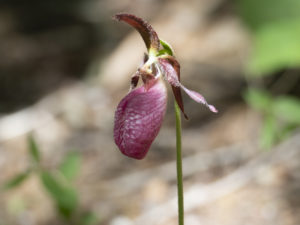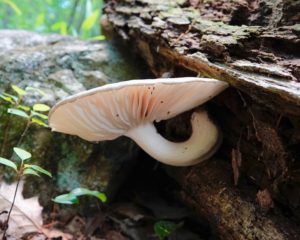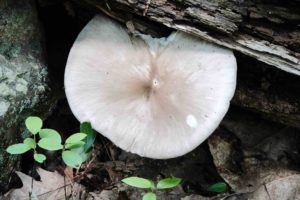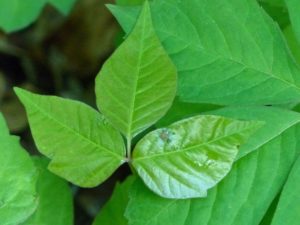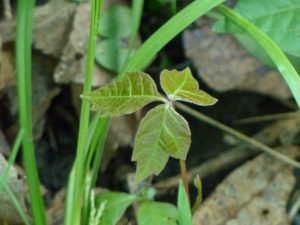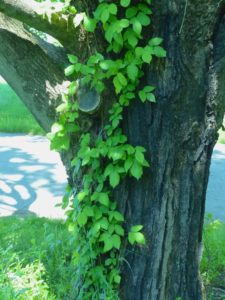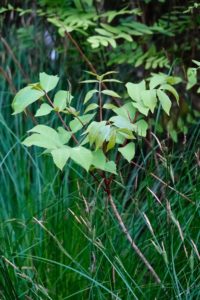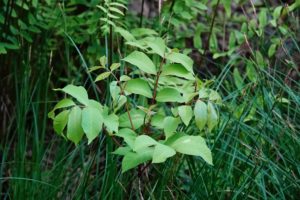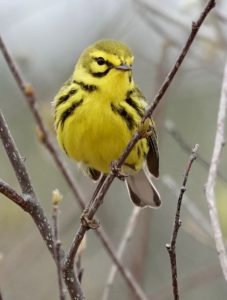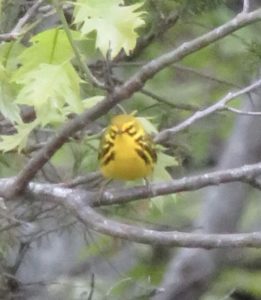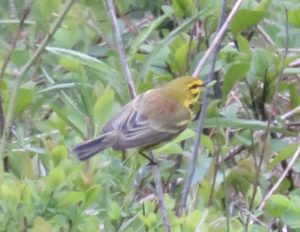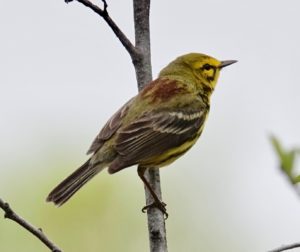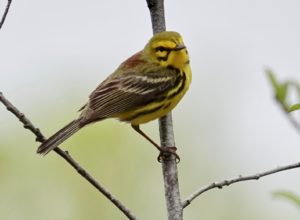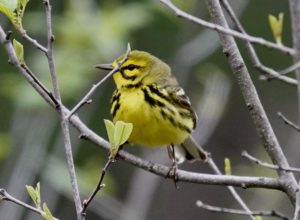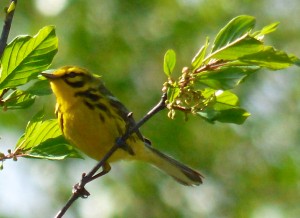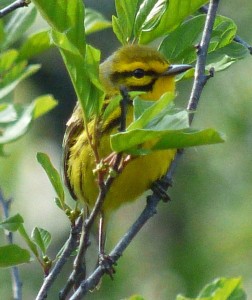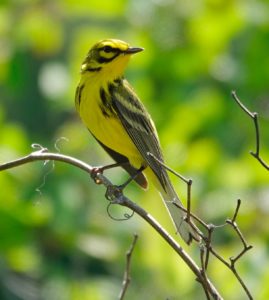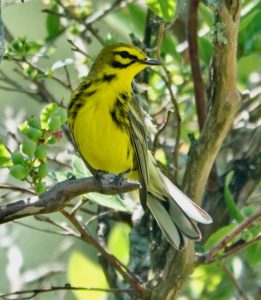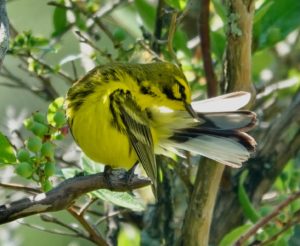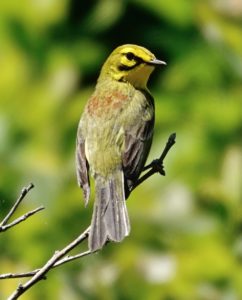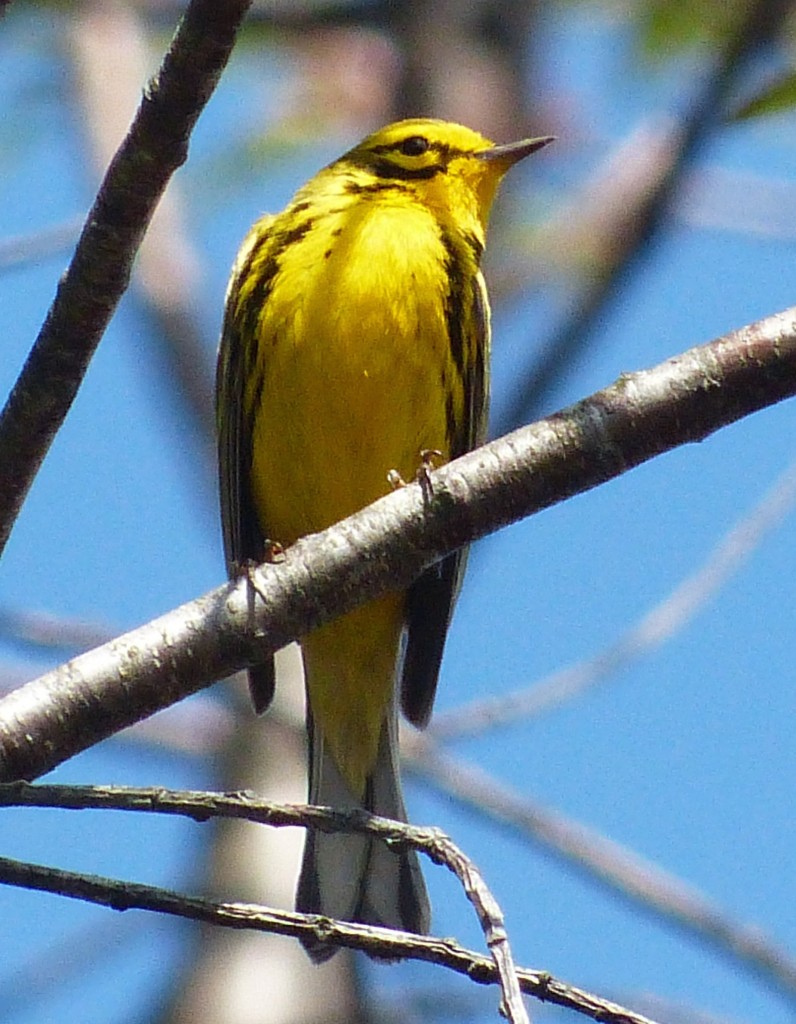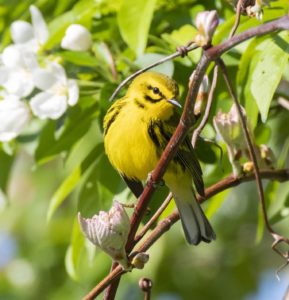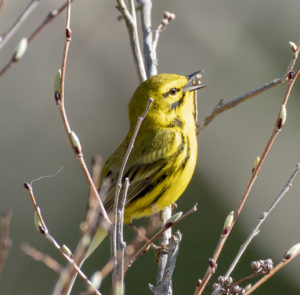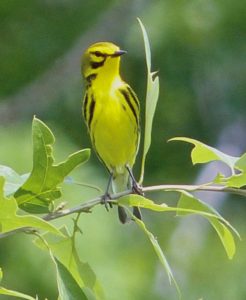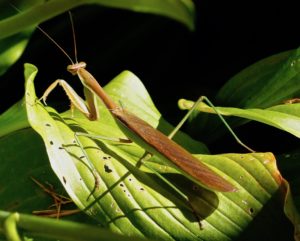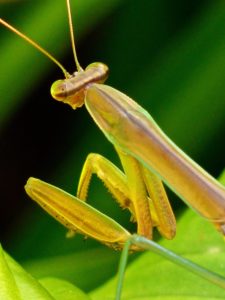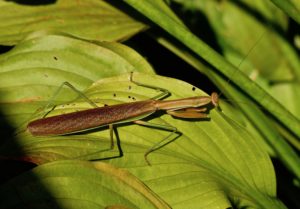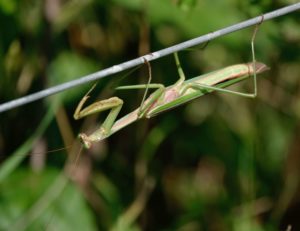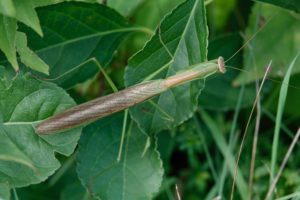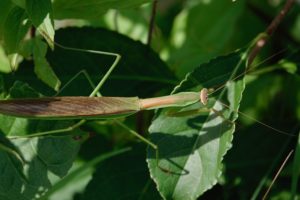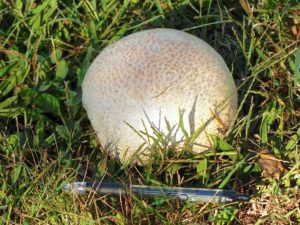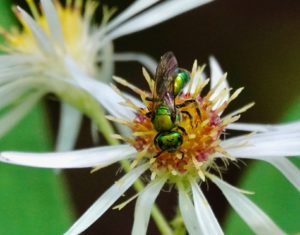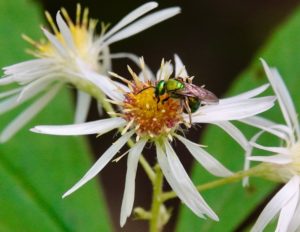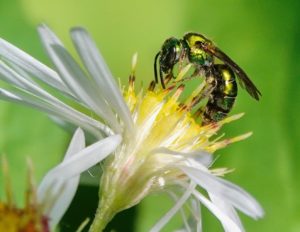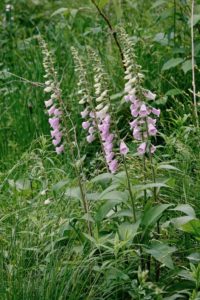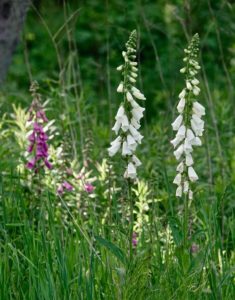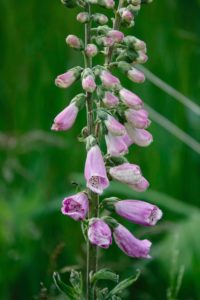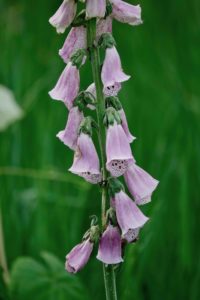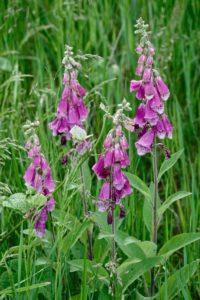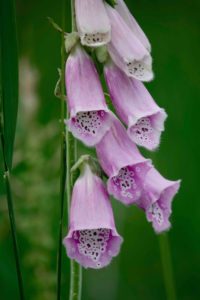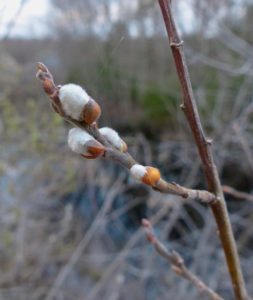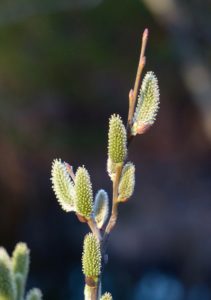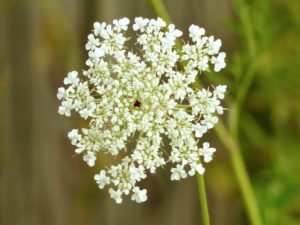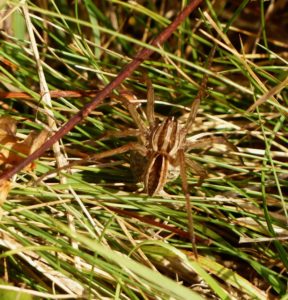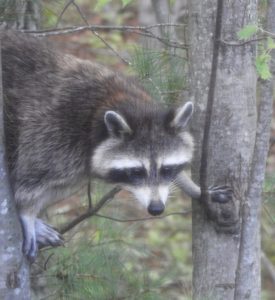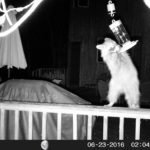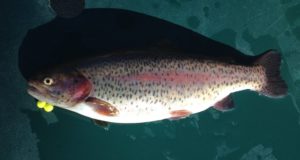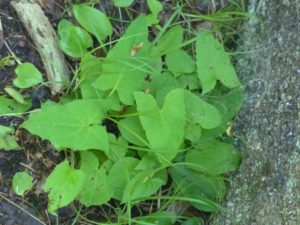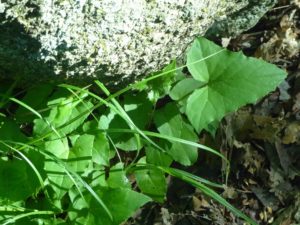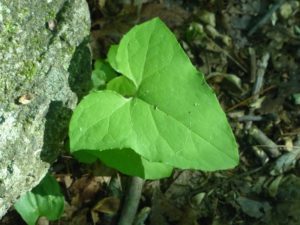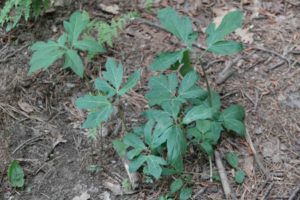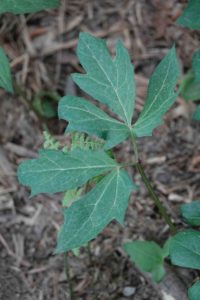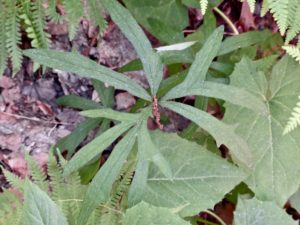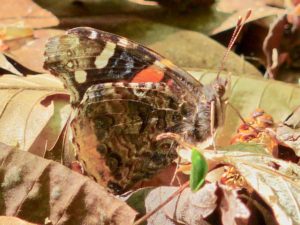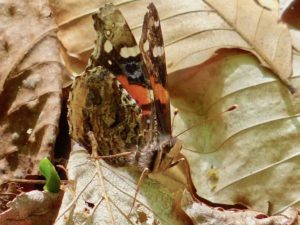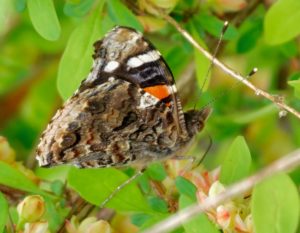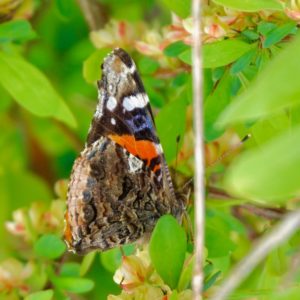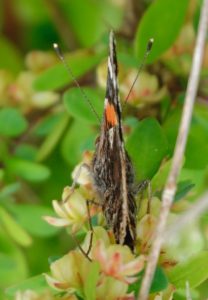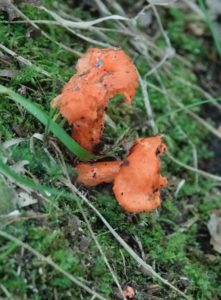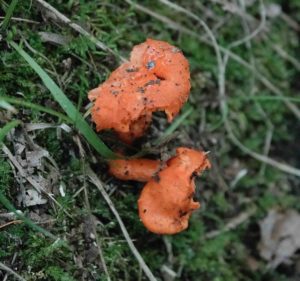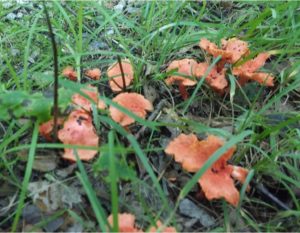Sightings grid
Observer: Josh Simons
Observation Date: 5/31/20
Observation Time: 10:30 a.m.
Observation Location: Moose Hill area
Common Name: Pink Lady’s Slipper orchid
Scientific Name: Cypripedium acaule
Comments: Pink lady’s slippers probably won’t survive if you try to transplant them, so please don’t dig them up.
More Information: Wikipedia
Observer: Paul Lauenstein
Observation Date: 6/13/20
Observation Time: 5:55 p.m.
Observation Location: Moose Hill Wildlife Sanctuary
Common Name: Platterful Mushroom
Scientific Name: Megacollybia rodmani
Comments: Platterful mushrooms appear after May and June rains. It had rained heavily two days earlier. This one was growing on a rotting log beside the trail.
More Information: Mushroomexpert.com
Top view:
Observer: Paul Lauenstein
Observation Date: 5/23/18
Observation Time: 9:35 a.m.
Observation Location: Moose Hill Farm (TTOR)
Common Name: Poison Ivy
Scientific Name: Toxicodendron radicans
Comments: Everyone should learn to identify poison ivy and avoid contact with its glossy, notched leaves. As both its common name and its scientific name suggest, the triplicate leaves of this plant can cause an intensely itchy rash that lasts for weeks. Jewelweed, which often grows near poison ivy, is also an antidote for poison ivy.
Poison ivy is often seen in disturbed areas along roads and paths, but it can also climb up trees as a thick vine. When ripe, the white fruits are a favorite food of many migrant and game birds, as well as white-tailed deer. The seeds are adapted for sprouting after digestion softens the seed coat.
More Information: Go Botany
Observer: Paul Lauenstein
Observation Date: 5/25/23
Observation Time: 6:45 a.m.
Observation Location: Moose Hill Audubon Wildlife Sanctuary (wetland boardwalk)
Common Name: Poison Sumac
Scientific Name: Toxicodendron vernix
Comments: Everyone should learn to identify poison sumac and avoid contact with it. As both its common name and its scientific name suggest, the leaves of this plant can cause an itchy rash.
Poison sumac is often found in marshy areas.
More Information: Healthline
Observer: Paul Lauenstein
Observation Date: 7/20/10
Observation Time: 7:30 a.m.
Observation Location: Gavins Pond Road soccer field parking lot
Common Name: Polyphemus Moth (wing only)
Scientific Name: Antheraea polyphemus
Comments: A few years ago, I saw a dead luna moth in the same area. Both polyphemus moths and luna moths are truly spectacular.
More Information: Auburn University
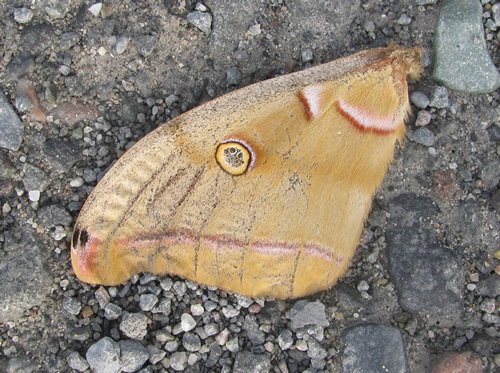
Observer: Paul Lauenstein
Observation Date: 8/16/20
Observation Time: 9:50 a.m.
Observation Location: 4 Gavins Pond Rd.
Common Name: Porcelain Gray Moth
Scientific Name: Protoboarmia porcelaria
Comments: This is a type of geometer moth. This individual was resting on my window in the morning.
Moths are typically nocturnal. One way to attract moths on a summer night is to hang a white sheet and put a light behind it.
More Information: Butterflies and Moths of North America
Observer: Paul Lauenstein
Observation Date: 5/11/20
Observation Time: 10:50 a.m.
Observation Location: under the power lines across the street from the Gavins Pond soccer fields
Common Name: Prairie Warbler
Scientific Name: Setophaga discolor
Comments: Prairie warblers are found in scrubby fields and forest edges throughout the eastern and south-central United States. Unlike many other warblers that migrate through Sharon in spring and fall, the prairie warbler hangs around all summer. You can find them in brushy areas under power lines, especially if you learn to recognize their ascending trill. This habitat is also good for indigo buntings.
More Information: All About Birds
Observer: Deb Radovsky
Observation Date: 5/12/18
Observation Time: 9:00 a.m.
Observation Location: Moose Hill Farm (TTOR), Powerline Trail
Common Name: Prairie Warbler
Scientific Name: Setophaga discolor
Comments: The Prairie Warbler is found in scrubby fields and forests throughout the eastern and south-central United States, not on the prairies. Unlike many other warblers that migrate through Sharon in spring and fall, the Prairie Warbler hangs around all summer.
More Information: All About Birds
Observer: Paul Lauenstein
Observation Date: 5/18/20
Observation Time: 10:25 a.m.
Observation Location: under the power lines across the street from the Gavins Pond soccer fields
Common Name: Prairie Warbler
Scientific Name: Setophaga discolor
Comments: Prairie warblers are found in scrubby fields and forest edges throughout the eastern and south-central United States. Unlike many other warblers that migrate through Sharon in spring and fall, the prairie warbler hangs around all summer. You can find them in brushy areas under power lines, especially if you learn to recognize their ascending trill. This habitat is also good for indigo buntings.
Note the reddish patch on its back.
More Information: All About Birds
Observer: Paul Lauenstein
Observation Date: 5/22/15
Observation Time: 4:20 p.m.
Observation Location: near Gavins Pond
Common Name: Prairie Warbler
Scientific Name: Setophagia discolor
Comments: Prairie warblers can be found in unforested areas such as those under the high-tension lines. I encountered this one in a field near Gavins Pond. If you learn to recognize their song, you will find them much easier.
More Information: All About Birds
Observer: Paul Lauenstein
Observation Date: 5/23/14
Observation Time: 5:15 p.m.
Observation Location: field near Gavins Pond dam
Common Name: Prairie warbler
Scientific Name: Setophaga discolor
Comments: Prairie warblers are typically found in open fields and under power lines. Listen for their ascending trill.
More Information: All About Birds
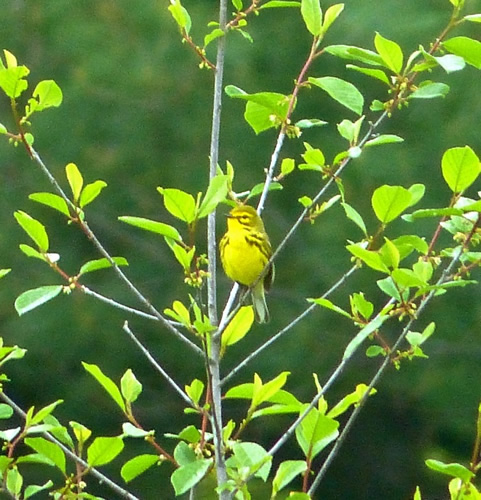
Observer: Paul Lauenstein
Observation Date: 5/28/23
Observation Time: 11:50 a.m.
Observation Location: Moose Hill Farm (TTOR) – under the power lines
Common Name: Prairie Warbler
Scientific Name: Setophaga discolor
Comments: Prairie warblers are found in scrubby fields and forest edges throughout the eastern and south-central United States. Unlike many other warblers that migrate through Sharon in spring and fall, the prairie warbler nests in Sharon and hangs around all summer. You can find them in brushy areas under power lines, especially if you learn to recognize their ascending trill. This habitat is also good for indigo buntings.
More Information: All About Birds
Observer: Paul Lauenstein
Observation Date: 5/4/24
Observation Time: 11:20 a.m.
Observation Location: Moose Hill Farm (TTOR) – under the power lines
Common Name: Prairie Warbler
Scientific Name: Setophaga discolor
Comments: Prairie warblers are found in scrubby fields and forest edges throughout the eastern and south-central United States. Unlike many other warblers that migrate through Sharon in spring and fall, the prairie warbler nests in Sharon and stays around all summer. You can find them in brushy areas under power lines, especially if you learn to recognize their ascending trill. This habitat is also a good place to look for indigo buntings in spring and summer.
More information: All About Birds
Observer: Paul Lauenstein
Observation Date: 5/6/15
Observation Time: 3:25 p.m.
Observation Location: field near Gavins Pond
Common Name: Prairie Warbler
Scientific Name: Setophaga discolor
Comments: This striking yellow and black warbler has a high-pitched trill that ascends. It can be seen in open fields and under power lines all summer in Sharon.
More Information: All About Birds
Observer: Jason Platt
Observation Date: 5/8/18
Observation Time: 8:30 a.m.
Observation Location: under power lines at Moose Hill
Common Name: Prairie Warbler
Scientific Name: Setophaga discolor
Comments: This striking yellow and black warbler has a high-pitched trill that ascends. It can be seen in open fields and under power lines all summer in Sharon.
More Information: All About Birds
Observer: Paul Lauenstein
Observation Date: 6/17/13
Observation Time: 4:30 p.m.
Observation Location: field near Gavins Pond
Common Name: Prairie warbler
Scientific Name: Setophaga discolor
Comments: Prairie warblers are not hard to find in fields and cleared areas under high tension lines in Sharon from May to August. Listen for their ascending trill.
More Information: All About Birds
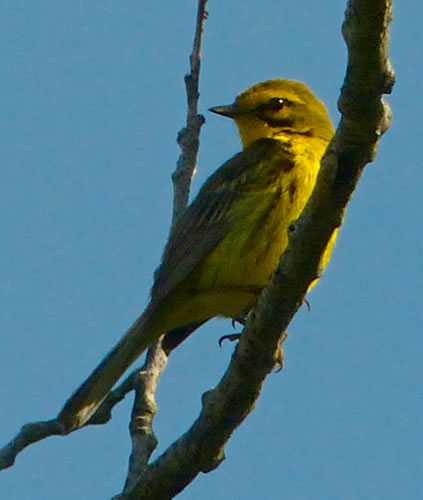
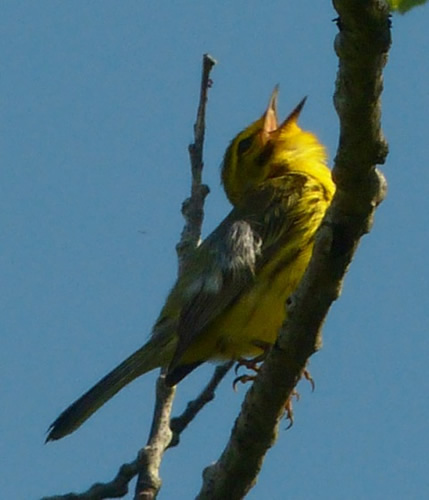
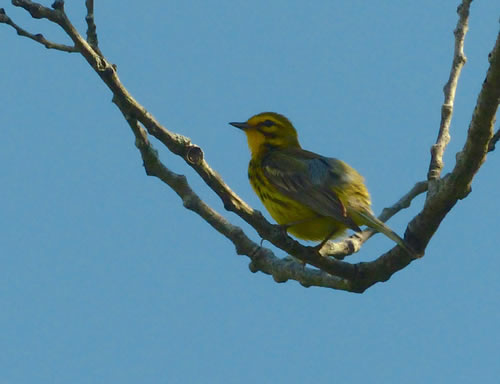
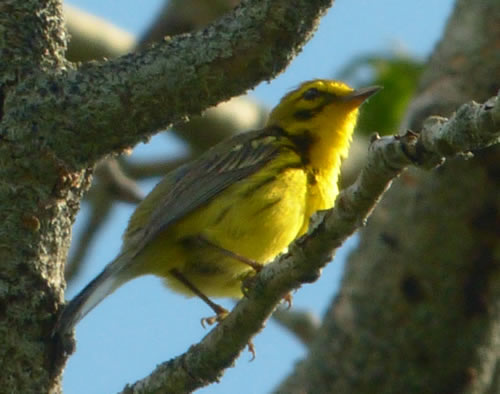
Observer: Paul Lauenstein
Observation Date: 6/2/19
Observation Time: 1:20 p.m.
Observation Location: on the bluff beneath the power lines that parallel So. Walpole St.
Common Name: Prairie Warbler
Scientific Name: Setophaga discolor
Comments: Prairie warblers are found in scrubby fields and forests throughout the eastern and south-central United States, not on the prairies. Unlike many other warblers that migrate through Sharon in spring and fall, the Prairie Warbler hangs around all summer. You can find them in brushy areas under power lines, especially if you learn to recognize their ascending trill.
More Information: All About Birds
Observer: Paul Lauenstein
Observation Date: 10/8/08
Observation Time: 11:20 a.m.
Observation Location: Gavins Pond Road backyard
Common Name: Praying Mantis
Scientific Name: Mantis religiosa
Comments: Check out this enormous praying mantis I found in my raspberry patch today. It’s about 5 inches long. I wonder if it descended from the praying mantis egg cases we mail-ordered a few years ago to help control insect pests in our garden.
Mantises are ambush predators that only feed upon live prey within their reach. They either camouflage themselves and remain stationary, waiting for prey to approach, or stalk their prey with slow, stealthy movements. Larger mantises sometimes eat smaller individuals of their own species, as well as small vertebrates such as lizards, frogs, and even small birds.
More Information: Wikipedia
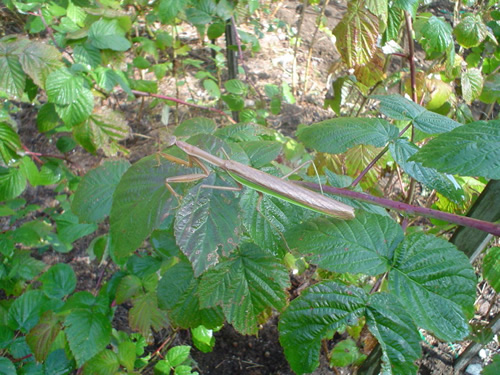
Observer: Paul Lauenstein
Observation Date: 7/30/13
Observation Time: 5:50 p.m.
Observation Location: Gavins Pond Road backyard
Common Name: Praying Mantis
Scientific Name: Mantis religiosa
Comments: This insect looks like it is praying, hence the name. It can swivel its head 180° to look for prey.
More Information: Wikipedia
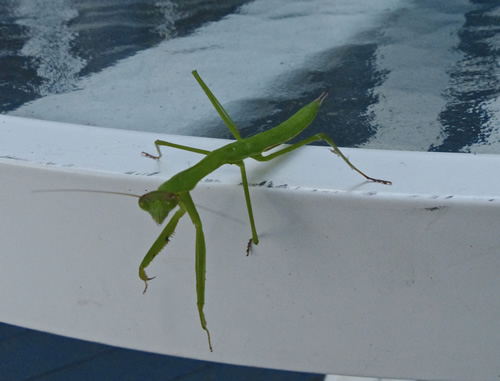
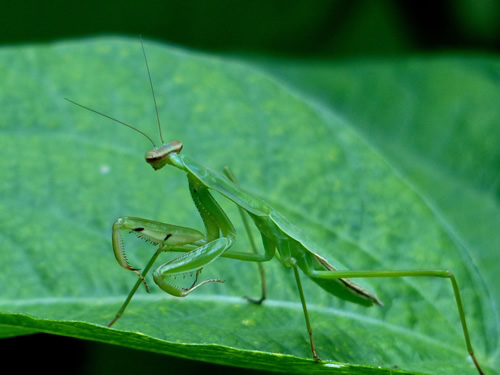
Observer: Paul Lauenstein
Observation Date: 9/14/14
Observation Time: 10:00 a.m.
Observation Location: 4 Gavins Pond Rd.
Common Name: Praying Mantis
Scientific Name: Mantis religiosa
Comments: This praying mantis was almost 4″ long. It could be a descendant of praying mantises that hatched from eggs we mail-ordered and released in our garden years previously.
More Information: Praying mantis love-making
Observer: Paul Lauenstein
Observation Date: 9/4/20
Observation Time: 12:50 p.m.
Observation Location: Moose Hill Farm (TTOR)
Common Name: Praying Mantis
Scientific Name: Mantis religiosa
Comments: Mantises are the only insects capable of turning their heads from side to side. Being able to turn its head without moving the rest of its body is a key advantage for a mantis when hunting, allowing for minimal movement as it sneaks up on prey.
More Information: Treehugger
Observer: Paul Lauenstein
Observation Date: 6/24/10
Observation Time: 3:40 p.m.
Observation Location: Beaver Brook near tennis courts
Common Name: Princess pine
Scientific Name: Dendrolycopodium obscurum
Comments: Despite its name and pine-like appearance, princess pine is not related to pine trees. It’s actually a type of clubmoss, an ancient group of plants that had its heyday long before there were pines, dinosaurs, or flowering plants. Also known as “ground cedar,” it is also called “fan clubmoss” because of its fan-like branches. It grows from a creeping stem at the soil surface.
More Information: Westborough Land Trust
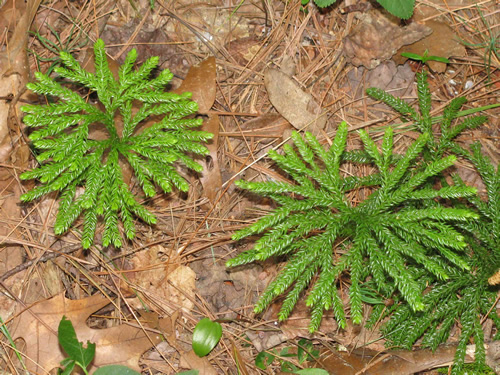
Observer: Paul Lauenstein
Observation Date: 9/20/15
Observation Time: 4:20 p.m.
Observation Location: Lake Massapoag (near boat ramp)
Common Name: Puffball mushroom
Scientific Name: Genus: Calvatia, Bovista and others
Comments: There are many kinds of puffballs. Some are edible and some are poisonous.
More Information: eattheplanet.org
Observer: Paul Lauenstein
Observation Date: 9/4/20
Observation Time: 1:10 p.m.
Observation Location: Moose Hill Farm (TTOR)
Common Name: Pure Gold-Green Sweat Bee
Scientific Name: Augochlora pura
Comments: The pure gold-green sweat bee is a solitary sweat bee native to the eastern United States with striking green iridescence. This species is an important native pollinator in eastern deciduous forests and other habitats. It emerges in spring and remains active throughout the summer and early fall. As the common name of this group suggests, sweat bees are attracted to human sweat, which they lick to consume salts.
The specimen in the photos was feeding on a whorled wood aster blossom in the woods.
More Information: U. of Florida Featured Creatures
Observer: Josh Simons
Observation Date: 6/25/11
Observation Time: 1:00 p.m.
Observation Location: Moose Hill area
Common Name: Purple Finch
Scientific Name: Carpodacus purpureus
Comments: Probably decreased in Northeast in late 19th century after introduction of House Sparrow. In recent decades has declined further in that area, possibly owing to competition with House Finch.
More Information: audubon.org or All About Birds
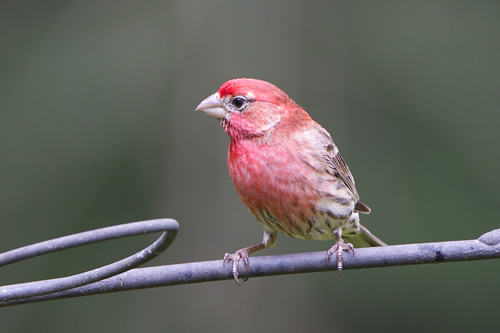
Observer: Paul Lauenstein
Observation Date: 6/13/20
Observation Time: 5:15 p.m.
Observation Location: Moose Hill Audubon Wildlife Sanctuary
Common Name: Purple Foxglove
Scientific Name: Digitalis purpurea
Comments: Purple foxglove, Digitalis purpurea, is a biennial or short-lived herbaceous perennial from western Europe in the plantain family. It is sometimes called common foxglove, fairy gloves, fairy bells, or lady’s glove. Purple foxglove is naturally quite variable in size and flower color.
As its scientific name suggests, foxglove was the source of chemicals in the drug digitalis.
More Information: University of Wisconsin
Observer: Paul Lauenstein
Observation Date: 9/12/09
Observation Time: 11:20 a.m.
Observation Location: Gavins Pond
Common Name: Purple Loosestrife
Scientific Name: Lythrum salicaria L.
Comments: Sometimes called “purple plague,” purple loosestrife is an invasive species. Neponset River Watershed Association has a program to propagate and disperse galerucella beetles that eat nothing but purple loosestrife.
More Information: The Nature Conservancy
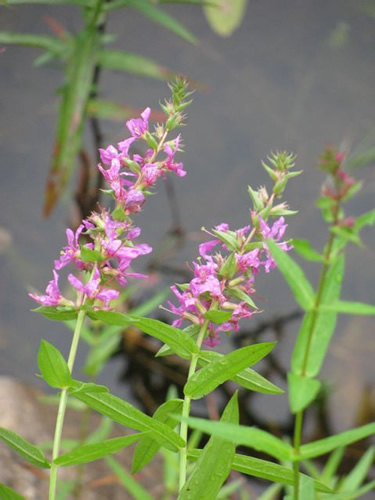
Observer: Paul Lauenstein
Observation Date: 5/29/14
Observation Time: 11:30 a.m.
Observation Location: Borderland State Park
Common Name: Purple pitcherplant
Scientific Name: Sarracenia purpurea
Comments: This carnivorous plant captures and digests hapless insects.
More Information: Harvard Forest
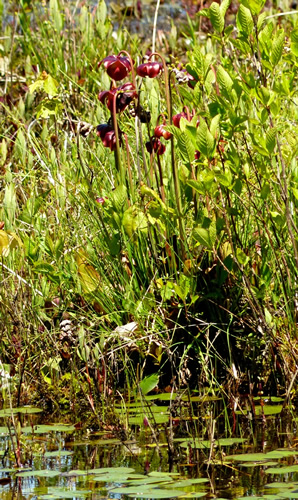
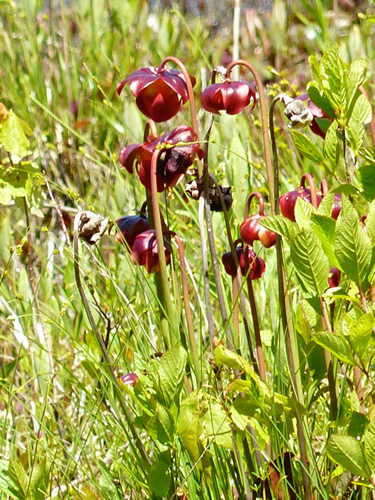
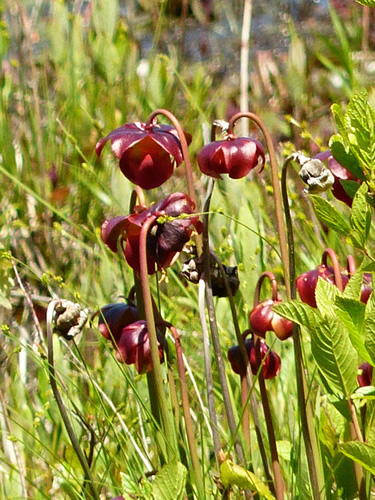
Observer: Paul Lauenstein
Observation Date: 4/13/13
Observation Time: 5:50 p.m.
Observation Location: near Gavins Pond
Common Name: Pussy Willow
Scientific Name: Salix discolor
Comments: The fuzzy nubs that appear on pussy willows in early spring are actually flowers just before they fully bloom. The species most commonly called pussy willow in the Northeast, Salix discolor, is a small, shrubby species of willow that can be found dotting wetlands and moist woods throughout much of North America.
More Information: Brooklyn Botanic Garden
Observer: Paul Lauenstein
Observation Date: 7/22/15
Observation Time: 5:20 p.m.
Observation Location: Gavins Pond area
Common Name: Queen Anne’s Lace
Scientific Name: Daucus carota
Comments: Daucus carota, whose common names include wild carrot, bird’s nest, bishop’s lace, and Queen Anne’s lace (North America), is a white, flowering plant in the family Apiaceae, native to temperate regions of Europe and southwest Asia, and naturalized to North America and Australia.
Domesticated carrots are cultivars of a subspecies, Daucus carota subsp. sativus.
More Information: Wikipedia
Observer: Paul Lauenstein
Observation Date: 6/29/11
Observation Time: 11:30 a.m.
Observation Location: Gavins Pond
Common Name: Question Mark butterfly
Scientific Name: Polygonia interrogationis
Comments: There’s a similar Eastern Comma butterfly that is also found in Sharon.
More Information: Butterflies and Moths of North America
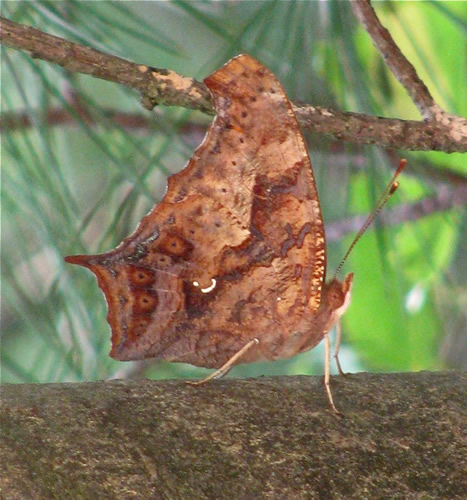
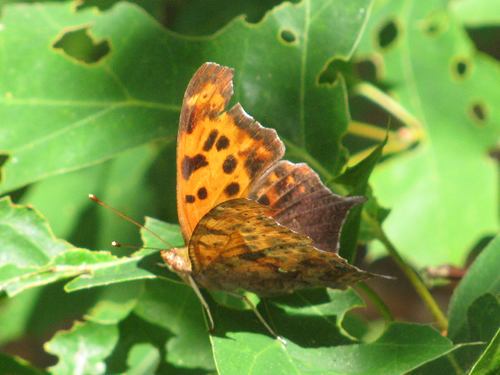
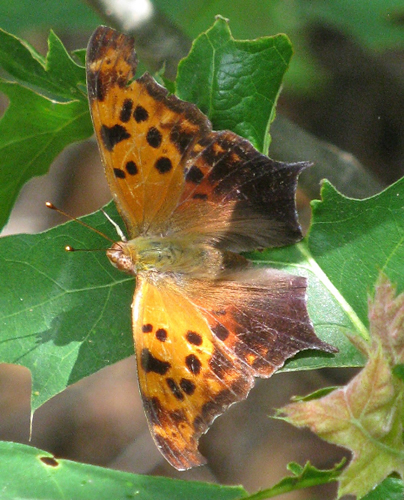
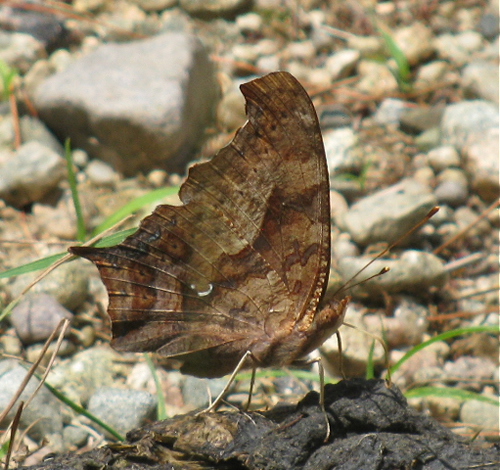
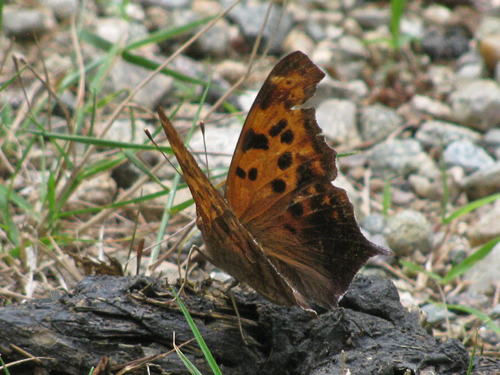
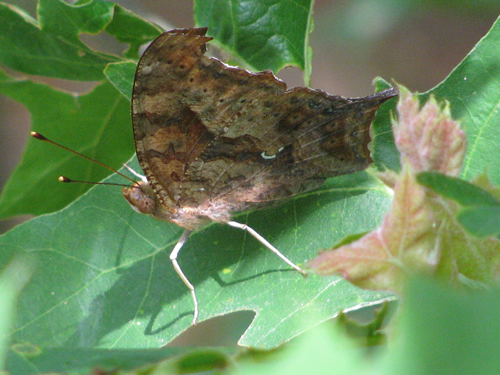
Observer: Paul Lauenstein
Observation Date: 7/31/12
Observation Time: 11:45 a.m.
Observation Location: Gavins Pond Road (bridge near soccer fields)
Common Name: Question Mark butterfly chrysalis
Scientific Name: Polygonia interrogationis
Comments: This is the chrysalis of a Question Mark butterfly. They have a white mark on each wing that looks like a question mark. See photos of an adult Question Mark Butterfly. The root “interrogation” is apparent in the scientific name “interrogationis” and relates to the odd white question mark on its wing.
More Information: Wikipedia
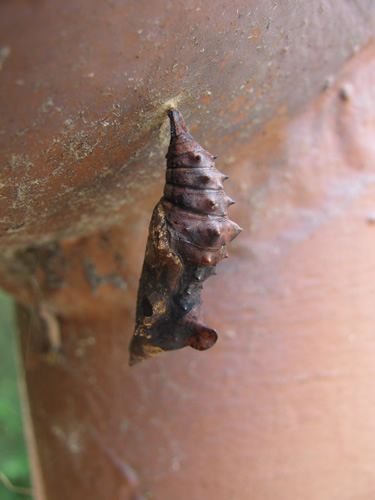
Observer: Rebecca Hickman
Observation Date: 7/17/12
Observation Time: n/a
Observation Location: Back yard
Common Name: Rabbit, Hawk, and Turkeys
Scientific Name: n/a
Comments: This past week, beginning last weekend, has been like watching an episode of National Geograhpic in my back yard. I’m exaggerating, but not by much..
I enjoy watching the little bunny that has taken up residency under our shed in our back yard.. I’m outside a lot, and I see him munching clover all the time.
Sunday morning I was outside having my morning cup of joe, and watching the bunny hop around on the freshly mowed lawn. Just then, what I’m assuming was a hawk came and snatched him. It happened so suddenly! At first I gasped and weakly yelled “no!” as the big bird of prey flew off with the fluffy guy. The area beyond our back yard is heavily wooded, and the trees are very tall so much of the aerial view is obscured by them and I didn’t see much more. I would have known it was a hawk with more certainty if I saw it flying more. My only good view of him was by the back of his wings when he came down, and took off. It was sad to see the bunny go, but mostly it was an amazing thing to see and I’m glad I got too see such a moment in person.
Then, yesterday I went outside to grill some hot dogs and there were two big turkeys in the yard. I grabbed my toddler and brought him out for a peek, but I knew to stay close to the safety of the door. I know from past experience that turkeys can be aggressive. The experience was when my curiousity brought me close to a pack of turkeys while I was driving in Scituate. The turkeys charged and gobble- gobbled and attacked the tires of our mini van. I was so startled that I told my husband to lock the doors. I started laughing at the silliness of my reaction, but when I saw that he actually DID lock his door, I laughed even more.
Observer: Paul Lauenstein
Observation Date: 9/24/14
Observation Time: 11:20 a.m.
Observation Place: TTOR’s Moose Hill Farm (formerly the Kendall Estate)
Common Name: Rabid Wolf Spider
Scientific Name: Rabidosa rabida
Comments: This species doesn’t build webs to catch prey. Instead, they ambush or chase their prey at night. They then wrap their prey in silk. Note the egg sac in the photo below, which was taken in late September.
More Information: Wikipedia
Observer: Rick Dumont
Observation Date: 5/21/09
Observation Time: 9:00 a.m.
Observation Location: Belcher St.
Common Name: Raccoon
Scientific Name: Procyon lotor
Comments: The raccoon is mostly nocturnal. It is also solitary, except for mothers and their young. In the winter the raccoon may sleep in its den for a few weeks but it does not hibernate. The raccoons usually walks, but it can run at speeds of up to 15 miles an hour. It is also a good swimmer and often hunts for food in the water. The raccoon makes a variety of vocalizations including hisses, whistles, screams, growls and snarls.
More Information: Nature Works

Observer: Josh Simons
Observation Date: 6/19/20
Observation Time: 3:30 p.m.
Observation Location: Moose Hill area
Common Name: Raccoon
Scientific Name: Procyon lotor
Comments: Raccoons are mainly nocturnal, but this family was out foraging during the day. Raccoons are smart and quite capable of defending themselves against dogs or anything else that might try to harass them.
More Information: National Geographic
Observer: Richard Mandell
Observation Date: 8/20/2016
Observation Time: 2:00 p.m.
Observation Location: Mountain Street
Common Name: Raccoon
Scientific Name: Procyon lotor
Comments: Unusual to see out during the day, as raccoons are mainly nocturnal. Probably looking for the bird feeders, which I now take in at night since raccoons plundered them at night. Check out the nighttime photo I took of a raccoon trying to get sugar water from our hummingbird feeder. It’s posted at this site.
More Information: National Geographic
Observer: Richard Mandell
Observation Date: 6/23/16
Observation Time: 2:04 a.m.
Observation Location: 580 Mountain Street (Back Deck)
Common Name: Raccoon
Scientific Name: Procyon lotor
Comments: This explains why the hummingbirds seemed so thirsty that the feeder was emptying every night.
More Information: Living with Wildlife
Observer: Kurt Buermann
Observation Date: 6/16/20
Observation Time: 8:20 p.m.
Observation Location: Furnace Street
Common Name: Raccoon and Gray Fox
Scientific Name: Procyon lotor and Urocyon cinereoargenteus
Comments: This raccoon and gray fox – both of which are predators – were feeding peacefully together on the porch.
More Information: Wikipedia and Nature Works
Here’s a link to the video: https://www.youtube.com/watch?v=BX-v4iZD_j4
Observer: Steven D’Addieco
Observation Date: 3/8/17
Observation Time: noon
Observation Location: Lake Massapoag
Common Name: Rainbow trout
Scientific Name: Oncorhynchus mykiss
Comments: I remember casting out into the shallow water until suddenly when I was reeling my line in I realized I had a fish on the line and reeled it in.
It turns out that I accidentally snagged this Rainbow Trout.
More Information: Trout Stocking Report
Observer: Paul Lauenstein
Observation Date: 6/23/19
Observation Time: 12:32 p.m.
Observation Location: Billings Loop Botanical Trail
Common Name: Rasberry Slime Mold
Scientific Name: Amoebozoa
Comments: Slime molds are in the phylum Amoebozoa, and are related to amoeba. Slime molds are aggregates of single-celled organisms that can grow up to 9 feet long! Slime molds typically aggregate to form a plasmodium — a multinucleate mass of undifferentiated cells that may move in an ameboid-like fashion during the search for nutrients. Slime molds are examples of cellular communication and differentiation, and may provide insights into how multicellular organisms develop.
More Information: I Love Slime Molds and So Should You
On the intelligence of slime molds: https://wyss.harvard.edu/news/thinking-without-a-brain/
Observer: Paul Lauenstein
Observation Date: 5/23/18
Observation Time: 8:10 a.m.
Observation Location: Moose Hill Audubon Wildlife Sanctuary
Common Name: Rattlesnake Root
Scientific Name: Prenanthes sp.
Comments: Roots look like the rattle of a rattlesnake.
More Information: Youtube
Observer: Paul Lauenstein
Observation Date: 6/9/20
Observation Time: 4:05 p.m.
Observation Location: trail near Brook Road
Common Name: Three-leaved Rattlesnake Root
Scientific Name: Nabalus trifoliolatus
Comments: Three-leaved rattlesnake-root is found throughout New England. It has a trumpet-shaped white flower that blooms in late summer.
More Information: GoBotany
Observer: Paul Lauenstein
Observation Date: 6/9/19
Observation Time: 4:05 p.m.
Observation Location: trail near Brook Road
Common Name: Three-leaved Rattlesnake Root
Scientific Name: Nabalus trifoliolatus
Comments: The leaves of this species of rattlesnake root look quite different from the arrowhead-shaped leaves of other kinds of rattlesnake root.
More Information: GoBotany
Observer: Paul Lauenstein
Observation Date: 5/11/12
Observation Time: 5:15 p.m.
Observation Location: Gavins Pond Road area
Common Name: Red Admiral butterfly
Scientific Name: Vanessa atalanta
Comments: Several of these Red Admirals were chasing after each other in a sunny clearing along a wooded dirt road near Gavins Pond.
More Information: Butterflies and Moths of North America
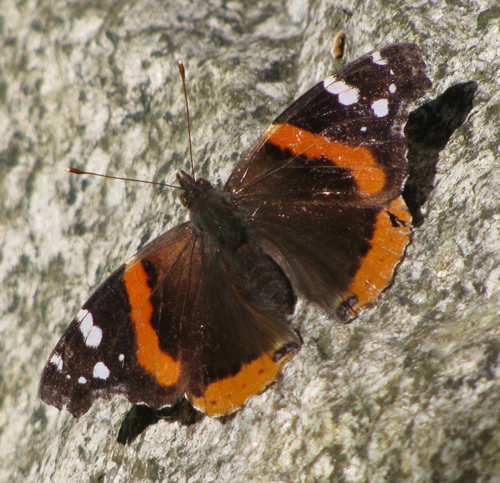
Observer: Paul Lauenstein
Observation Date: 5/19/19
Observation Time: 3:08 p.m.
Observation Location: Billings Loop Botanical Trail
Common Name: Red Admiral butterfly
Scientific Name: Vanessa atalanta
Comments: Mating usually occurs in late fall or early winter following collective migration to southern regions with a warmer climate. The red admiral’s main host plant, stinging nettle, is most abundant during this migration. Larval development proceeds through winter and adults are first sighted in early spring. The new generation of adults migrates north before mating, because food is usually diminished by late spring. During migration, the red admiral flies at high altitudes where high-speed winds carry the butterfly, requiring less energy.
More Information: Wikipedia
Observer: Paul Lauenstein
Observation Date: 5/4/24
Observation Time: 10:40 a.m.
Observation Location: Moose Hill Farm (Trustees of Reservations)
Common Name: Red Admiral butterfly
Scientific Name: Vanessa atalanta
Comments: Mating usually occurs in late fall or early winter following collective migration to southern regions with a warmer climate. The red admiral’s main host plant, stinging nettle, is most abundant during this migration. Larval development proceeds through winter and adults are first sighted in early spring. The new generation of adults migrates north before mating, because food is usually diminished by late spring. During migration, the red admiral flies at high altitudes where high-speed winds carry the butterfly, requiring less energy.
More Information: Wikipedia
Observer: Paul Lauenstein
Observation Date: 5/7/11
Observation Time: 11:40 a.m.
Observation Location: 4 Gavins Pond Road
Common Name: Red Admiral butterfly
Scientific Name: Vanessa atalanta
Comments: Red Admirals prefer sap flows on trees, fermenting fruit, and bird droppings; visiting flowers only when these are not available. Then they will nectar at common milkweed, red clover, aster, and alfalfa, among others.
More Information: Butterflies and Moths of North America
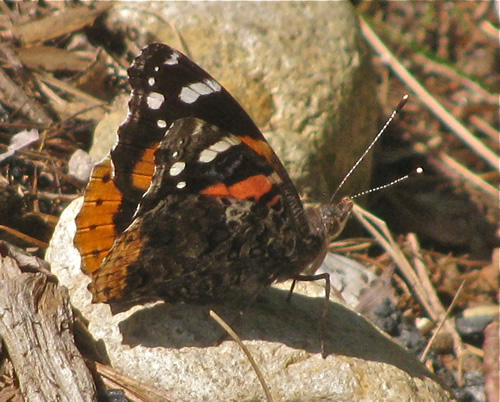
Observer: Lonnie Friedman
Observation Date: 7/11/20
Observation Time: 3:20 p.m.
Observation Location: Moose Hill Audubon Wildlife Sanctuary
Common Name: Red Chanterelle Mushroom
Scientific Name: Cantharellus cinnabarinus
Comments: Red chanterelles are fungi native to eastern North America. They are members of the genus Cantharellus along with other chanterelles. They are named after their red color, which is imparted by the carotenoid canthaxanthin. They are edible, fruiting in association with hardwood trees in the summer and fall.
It looks like something was chewing on the red chanterelles in these photos. It is a bad idea to ingest wild mushrooms unless you are absolutely certain you know what your are eating, because many mushrooms are poisonous.
More Information: iNaturalist
Observer: Kurt Buermann
Observation Date: 7/30/2017
Observation Time: N/A
Observation Location: Rattlesnake Hill, Sharon
Common Name: Red Chanterelle mushroom (a.k.a. Cinnabar Chanterelle mushroom)
Scientific Name: Cantharellus cinnabarinus
Comments: Sought after edible mushroom with slight peppery taste and slight apricot aroma.
DON’T EAT WILD MUSHROOMS UNLESS YOU ARE ABSOLUTELY SURE THEY ARE NOT POISONOUS!
More Information: The Mushroom Forager

